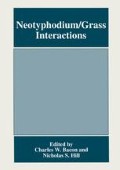Abstract
The discovery of the anti-herbivore properties of Neotyphodium endophytes, most of the available literature suggests that these endophytic fungi are plant defensive mutualists, and ecologists have readily extrapolated it to all endophyte-plant interactions (Breen 1994, Clay 1990). The current understanding of the mutualistic nature of endophytes is, however, dominated by studies of a few cultivars of two introduced and selectively bred agricultural grass species, tall fescue (Festuca arundinacea) and perennial ryegrass (Lolium perenne) using non-native vertebrate grazers or herbivorous insects. Many other grass species harboring the Neotyphodium endophytes are shown either not to produce mycotoxins or composition of produced mycotoxins varies (Siegel et al., 1990). Thus we propose that plant-endophyte interactions might be much more complex in native grasses under natural conditions than in the agricultural arena of selectively-bred, non-native pasture grasses described in past studies.
Access this chapter
Tax calculation will be finalised at checkout
Purchases are for personal use only
References
Breen, J.P. 1994. Acremonium endophyte interactions with enhanced plant resistance to insects. Ann. Rev. Entomol. 39: 40 1423.
Clay, K. 1990. Fungal endophytes of grasses. Ann. Rev. Ecol. Syst. 21: 275–279.
Siegel, M. C., Latch, G.C.M., Bush, L.P., Farm, F.F., Rowin, D.D., Tapper, B.A., Bacon, C.W. and Johnson, M.C. 1990: Fungal endophyte-infected grasses: Alkaloid accumulation and aphid response. J. Chem. Ecol. 16: 3301–3315.
Author information
Authors and Affiliations
Editor information
Editors and Affiliations
Rights and permissions
Copyright information
© 1997 Springer Science+Business Media New York
About this chapter
Cite this chapter
Faeth, S.H., Wilson, D., Helander, M., Saikkonen, K., Schulthess, F., Sullivan, T.J. (1997). Neotyphodium in Native Populations of Arizona Fescue. In: Bacon, C.W., Hill, N.S. (eds) Neotyphodium/Grass Interactions. Springer, Boston, MA. https://doi.org/10.1007/978-1-4899-0271-9_27
Download citation
DOI: https://doi.org/10.1007/978-1-4899-0271-9_27
Publisher Name: Springer, Boston, MA
Print ISBN: 978-1-4899-0273-3
Online ISBN: 978-1-4899-0271-9
eBook Packages: Springer Book Archive

